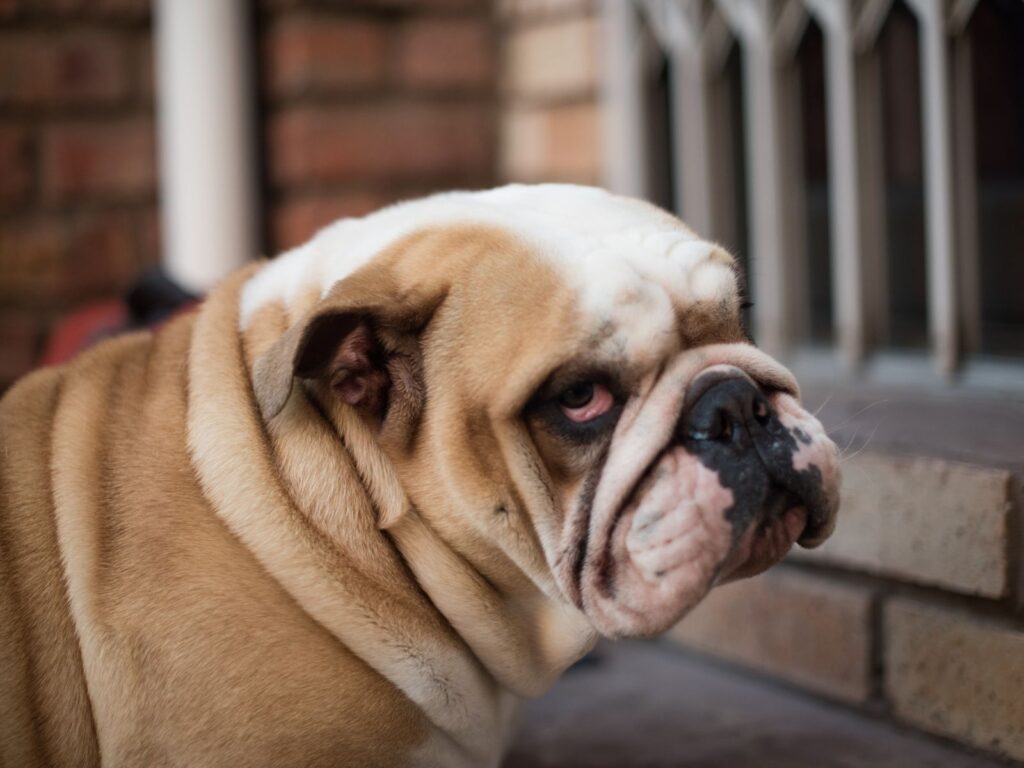Are bulldogs the saddest dogs? It’s a question that has been asked time and time again. Bulldogs are known for their wrinkly faces, droopy eyes, and saggy jowls, which many people believe give them a sad appearance. But is there any truth to this claim?
While it’s true that bulldogs have a unique appearance that some may interpret as sad, it’s important to note that this breed is known for its friendly and loyal personality. Bulldogs are often described as “sensitive souls” who crave human attention and affection. They are also known for their ability to adapt to different living environments, making them a popular choice for families and apartment dwellers alike.
So, are bulldogs the saddest dogs? The answer is no. While they may look sad to some, bulldogs are actually quite happy and content when they are surrounded by their loved ones.
It’s important to remember that a dog’s appearance doesn’t always reflect their true emotions, and that bulldogs, like all dogs, deserve to be loved and cared for just like any other pet.

Bulldogs’ Health Issues
Bulldogs are known for their adorable wrinkly faces and stocky build, but unfortunately, these features can also lead to a variety of health issues. Here are some of the most common health problems that Bulldogs face:
- Respiratory issues: Due to their short snouts, Bulldogs can have trouble breathing, especially in hot or humid weather. They are also prone to snoring and wheezing.
- Skin problems: The folds in a Bulldog’s skin can trap moisture and bacteria, leading to infections and irritation. Regular cleaning and grooming can help prevent these issues.
- Joint problems: Bulldogs are prone to hip and elbow dysplasia, which can cause pain and mobility issues. They are also at risk for spinal problems due to their short, stocky build.
- Dental issues: Bulldogs often have crowded teeth and a narrow jaw, which can lead to dental problems like gum disease and tooth decay. Regular dental care is important for their overall health.
It’s important to note that not all Bulldogs will experience these health issues, and responsible breeding practices can help reduce the risk. However, potential Bulldog owners should be aware of these risks and prepared to provide the necessary care and attention to keep their furry friend healthy and happy.

Bulldogs’ Temperament
Bulldogs are known for their friendly and affectionate nature. They are loyal and devoted to their owners, and are known to form strong bonds with them. Bulldogs are also known for their calm and gentle demeanor, which makes them great family pets. They are patient with children and other pets, and are not known to be aggressive.
However, Bulldogs can be stubborn at times, which can make training them a bit challenging. They have a tendency to be lazy and prefer lounging around the house rather than going for walks or playing fetch. This can make them prone to obesity if their diet and exercise routine is not monitored.
Despite their reputation for being sad dogs, Bulldogs are actually quite humorous and playful. They have a unique personality and are known to make their owners laugh with their silly antics. Bulldogs are also known to be quite affectionate, often seeking out attention from their owners by snuggling up to them on the couch or following them around the house.
Overall, Bulldogs have a gentle and friendly temperament that makes them great family pets. While they may require some patience and effort when it comes to training and exercise, their loyalty and affection make them a beloved breed among dog owners.

Bulldogs’ Exercise Needs
Bulldogs are known for their calm and laid-back personalities, but this doesn’t mean they should be couch potatoes. Despite their short legs and stocky build, Bulldogs still need regular exercise to maintain their health and happiness.
According to veterinarians, Bulldogs should get at least 30 minutes of exercise per day. This can be in the form of a brisk walk, a game of fetch, or other low-impact activities. It’s important to note that Bulldogs are prone to overheating, so exercise should be done in cooler temperatures and with plenty of water breaks.
While Bulldogs may not require as much exercise as other breeds, it’s still important to keep them active to prevent obesity and other health issues. Exercise can also help improve their mood and reduce stress, making them happier and more content.
Owners should also keep in mind that Bulldogs are not built for intense physical activity, such as running long distances or participating in agility courses. Instead, they thrive in more relaxed environments and activities that don’t put too much strain on their joints and respiratory system.

Bulldogs’ Emotional Well-being
It’s no secret that Bulldogs have a reputation for being sad dogs. But is this reputation justified? Let’s take a closer look at Bulldogs’ emotional well-being.
Firstly, it’s important to note that Bulldogs, like all dogs, have emotions. They can feel happy, sad, anxious, and everything in between. However, Bulldogs do have a few traits that can make them appear sadder than other breeds.
For example, Bulldogs are known for their wrinkly faces and droopy eyes, which can give them a perpetually sad expression. Additionally, Bulldogs are prone to certain health issues, such as breathing problems and joint pain, which can make them less active and more lethargic.
However, it’s important to note that not all Bulldogs are sad. Many Bulldogs are happy, playful, and full of energy. It all depends on the individual dog and their environment.
So, what can Bulldog owners do to ensure their furry friend’s emotional well-being? Here are a few tips:
- Provide plenty of exercise and playtime to keep your Bulldog active and engaged
- Ensure your Bulldog has a comfortable and safe living space
- Feed your Bulldog a healthy and balanced diet to maintain their physical health
- Give your Bulldog plenty of love and attention
By following these tips, Bulldog owners can help ensure their furry friend is happy and healthy.
Conclusion
After examining the various factors that contribute to a dog’s emotional state, it is clear that bulldogs are not inherently the saddest breed of dog. While they may have a naturally droopy face that can be mistaken for sadness, other breeds such as greyhounds and beagles have also been known to exhibit signs of depression.
Furthermore, a dog’s emotional state is largely dependent on its environment and the care it receives from its owner. Neglect, abuse, and lack of socialization can all contribute to a dog’s sadness, regardless of its breed.
It is important for dog owners to provide their pets with proper care, attention, and socialization to ensure their emotional well-being. Regular exercise, positive reinforcement training, and plenty of playtime can all contribute to a happy and healthy dog.
While bulldogs may not be the saddest breed of dog, it is important to recognize and address any signs of depression or sadness in all dogs. Seeking the advice of a veterinarian or animal behaviorist can help identify and address any underlying emotional issues in a dog.



